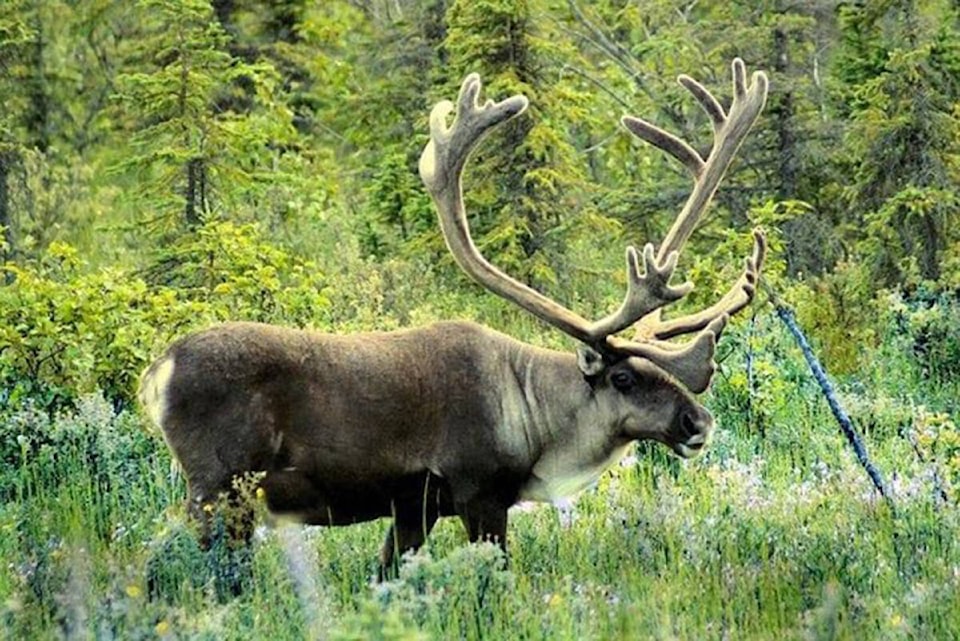By John Boivin, Local Journalism Initiative Reporter
A wildlife biologist says an enclosure designed to protect eight female caribou during calving season this spring is a last-chance attempt to save an endangered herd.
“These measures are extreme — we never want to be in this place,” says Aaron Reid. “It’s costly, it’s stressful — but without it, this herd would extirpate. Gone in five to 10 years.”
Reid was speaking at the end of February at the public opening of a maternity enclosure for the Southern Mountain Woodland caribou herd, located about 10 kilometres from Nakusp, near the community hot springs.
Reid told the two dozen guests the herd’s future relies on this enclosure working.
“Right now, we don’t have wild calf recruitment — it’s really low… and you really can’t grow a population without recruitment,” he said. “So these pens are really a last resort to double, triple that level, get them through that first week or two, when they’re the most vulnerable… you hold them as long as possible, then you release them, and they do quite well.”
Over the course of the last three years, the Arrow Lakes Caribou Society has been working on the plan to try to rescue the herd, which has fallen from 98 to just 28 members since the turn of the century. Raising more than $450,000, they’ve built a 1.2-kilometre, 10-foot-high fence around a 6.6-hectare forested area off the Kuskanax Forest Service Road. The area is shielded from prying eyes (both human and predator) by a heavy landscaping fabric hung along the fence’s entire length. Strands of 7,000-volt electric wire should keep unwanted visitors out. Volunteers have spent weeks collecting hundreds of kilometres of lichen to feed the mothers during their confinement.
Now, all is in readiness.
“We’re taking all the information we’ve learned from other pens in the province, and applying it to this operation,” says Paul Seaton, a wildlife biologist who’s acting as pen manager during the animals’ 12-week stay. “This is in a mature forest, a big hemlock-cedar stand, so there is beautiful habitat for them. Once you walk into the pen, you can really see it.”
The animals will be captured sometime in March, just a few kilometres away, where they’ve been spotted feeding on their winter grounds. A team of 40 biologists, veterinarians and handlers will carefully capture the pregnant animals, and use helicopters to bring them to the enclosure. The whole operation, says Seaton, will just take a few hours.
When the caribou moms-to-be wake up a few hours later, they’ll find themselves in a kind of a paradise for pregnant caribou. They’ll get plenty of fresh feed daily — lichen and animal feed pellets from a zoo (actually made for giraffes). There are misting stations where they can cool off, and snow is being piled up, to be covered in mulch to provide cool patches for the caribou to give birth. That will start in mid-May, and go to the end of June or so.
And they’ll be carefully watched over 24/7, both in person and over closed-circuit television.
“If there’s a wind event, or a tree falls down — the pen has to be monitored twice a day,” says Seaton, who’ll lead the crew of shepherds. “Every cow should be viewed twice a day, and we’ll keep records on each caribou. We’ll have a weigh scale on the feed station to monitor their health.”
The estimated cost of feeding and sheltering the animals this first year is $265,000.
Depending on how the animals are doing and the weather conditions, the caribou and their babies will be set free, simply by opening the gate the pen is actually just a short caribou trot away from the herd’s preferred summer feeding grounds up in the surrounding hills.
While the danger will be far from over, the 12 weeks or so they’ll care for the animals will give the herd an important head start.
“These cows will be in better shape walking out of the pen than they have ever been in their lives,” predicts Reid. “That’s a huge component of this. And the calves will be eating the feed too. They’ll be incredibly fit calves.”
If all goes well, the pen will likely be used for several seasons, and the ALCS hopes it will have a positive impact on both the caribou population and local community. However, the public is asked to stay away from the compound while the animals are in the pen. Access is highly restricted, and there will be no viewing platforms or spots around the perimeter to see the animals.
READ MORE: Kootenay snow packs drop slightly, still a bit above normal
Like us on Facebook and follow us on Twitter.
Want to support local journalism? Make a donation here.
